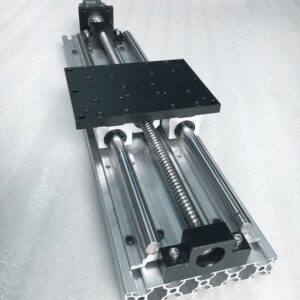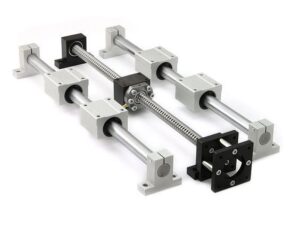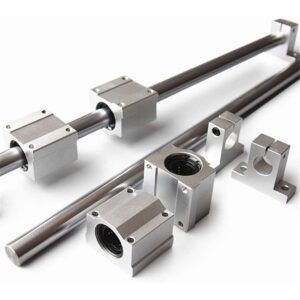Outline for “CNC Linear Guide”
| Main Topic | Subtopics |
|---|---|
| Introduction to CNC Linear Guide | Definition, role in CNC machines, why precision matters |
| What is a CNC Linear Guide? | Structure, materials, design elements |
| Importance of CNC Linear Guide in Manufacturing | Enhancing accuracy, speed, and repeatability |
| Types of CNC Linear Guides | Roller guides, ball guides, needle guides |
| Ball vs Roller CNC Linear Guide | Pros, cons, use cases |
| Key Components of CNC Linear Guide | Rails, blocks, rolling elements, seals |
| How CNC Linear Guide Works | Movement principles, load distribution |
| Benefits of CNC Linear Guide | Reduced friction, longer life, higher productivity |
| Applications of CNC Linear Guide | CNC milling, lathes, 3D printing, robotics |
| CNC Linear Guide in High-Speed Machining | Handling speed, accuracy, vibrations |
| Durability Factors in CNC Linear Guide | Lubrication, maintenance, environment |
| Common Problems with CNC Linear Guide | Misalignment, wear, contamination |
| How to Install CNC Linear Guide Correctly | Step-by-step installation process |
| Maintenance Tips for CNC Linear Guide | Cleaning, lubrication intervals, inspection |
| CNC Linear Guide Lubrication | Types of lubricants, methods of application |
| Signs Your CNC Linear Guide Needs Replacement | Unusual noise, uneven cuts, backlash |
| CNC Linear Guide vs Traditional Sliding Systems | Efficiency, precision, lifespan |
| How CNC Linear Guide Improves Productivity | Faster cycle times, consistent quality |
| Cost Considerations of CNC Linear Guide | Price factors, ROI in long term |
| Top CNC Linear Guide Brands in Market | Hiwin, THK, NSK, Bosch Rexroth |
| Choosing the Right CNC Linear Guide for Your Machine | Load capacity, speed, environment |
| Future of CNC Linear Guide Technology | Smart sensors, AI-driven monitoring |
| Real-World Case Studies of CNC Linear Guide | Success stories from industries |
| Frequently Asked Questions about CNC Linear Guide | At least six FAQs with answers |
| Conclusion | Final thoughts, summary |
Introduction to CNC Linear Guide
Manufacturing is a dance between speed, accuracy, and durability. At the heart of this balance lies the CNC linear guide, a small yet mighty component responsible for ensuring smooth, precise, and repeatable movement in CNC machines. Imagine trying to carve intricate patterns or cut metals at micro-level accuracy without a stable motion system—it would be chaos.
Linear guides eliminate this chaos by providing straight-line motion with minimal resistance. They are designed to handle heavy loads, resist wear, and extend machine life. For industries ranging from aerospace to woodworking, CNC linear guides represent the foundation of dependable, high-quality output.
What is a CNC Linear Guide?
A CNC linear guide is essentially a motion system that enables a block or carriage to move along a rail with reduced friction. Unlike traditional sliding mechanisms that rely on surface contact, these guides use rolling elements such as balls or rollers.
Key features include:
High precision: Perfect for CNC machining where even a fraction of a millimeter matters.
Rigidity: Supports heavy loads without flexing.
Longevity: With proper lubrication and care, these guides can last for years.
They are crafted from hardened steel or advanced alloys, designed to withstand intense pressure and continuous use.
Importance of CNC Linear Guide in Manufacturing
Why are CNC linear guides so critical? The answer lies in three factors:
Accuracy: Every cut, drill, or movement must be exact. Linear guides ensure repeatability.
Speed: Without smooth motion, CNC machines cannot achieve high feed rates.
Durability: Production environments demand components that last under extreme conditions.
In short, CNC linear guides bridge the gap between raw machine power and the finesse of precision manufacturing.
Types of CNC Linear Guides
Different applications demand different types of guides. The three main types include:
Ball Guides: Use steel balls for smooth movement, ideal for high-speed operations.
Roller Guides: Utilize cylindrical rollers, offering higher load capacity.
Needle Guides: Compact and precise, often used in specialized applications.
Each type has its own strengths depending on whether speed, load, or space is the priority.
Ball vs Roller CNC Linear Guide
When choosing between ball and roller guides, consider:
Ball Guides: Lightweight, fast, excellent for medium loads. They are widely used in 3D printers and small CNC machines.
Roller Guides: More rigid, capable of handling heavier loads, perfect for milling machines and heavy-duty CNC setups.
While ball guides excel in speed, roller guides dominate in strength. The choice ultimately depends on your specific production needs.
Key Components of CNC Linear Guide
A CNC linear guide is made of several integral parts:
Rails: The hardened steel tracks that provide the path.
Blocks (Carriages): Moving units that house rolling elements.
Rolling Elements: Either balls or rollers that minimize friction.
End Caps & Seals: Keep out contaminants like dust and chips.
Lubrication Ports: Ensure smooth, continuous motion.
Each part plays a vital role in achieving optimal performance.
How CNC Linear Guide Works
The working principle is straightforward yet ingenious. Rolling elements inside the carriage move in a continuous circulation system as the block travels along the rail. This rolling action drastically reduces friction compared to sliding motion, ensuring consistent accuracy and extended service life.
The load is distributed evenly across the rolling elements, allowing the guide to handle immense pressure without deformation.
Benefits of CNC Linear Guide
The advantages are vast:
Reduced Friction: Less energy wasted in overcoming resistance.
Higher Accuracy: Essential for industries like aerospace and medical devices.
Increased Productivity: Faster cycle times and smoother operation.
Longer Service Life: With proper maintenance, linear guides outlast traditional systems.
In short, CNC linear guides make machines faster, more accurate, and more reliable.
Applications of CNC Linear Guide
CNC linear guides are everywhere:
CNC Milling Machines: Precision cutting and shaping.
Lathes: Consistent turning with tight tolerances.
3D Printers: Smooth axis motion for high-quality prints.
Robotics: Seamless linear motion in automation.
Laser Cutting Machines: Stable and vibration-free operation.
Their versatility makes them indispensable across industries.
CNC Linear Guide in High-Speed Machining
High-speed machining demands stability at extreme feed rates. Linear guides provide:
Reduced vibration for cleaner cuts.
Ability to maintain accuracy even at top speeds.
Improved surface finish due to steady movement.
This is why industries like electronics and aerospace depend heavily on advanced CNC linear guides.
Durability Factors in CNC Linear Guide
Several factors influence durability:
Lubrication: Prevents wear and tear.
Maintenance: Regular cleaning extends lifespan.
Operating Environment: Dust, coolant, and temperature impact performance.
A well-maintained linear guide can last for thousands of operational hours.
Common Problems with CNC Linear Guide
Even the best systems face challenges:
Misalignment: Leads to uneven wear.
Contamination: Dust and chips can damage rolling elements.
Lubrication Failure: Causes friction and premature failure.
Identifying issues early saves time and costly repairs.
How to Install CNC Linear Guide Correctly
Installation is critical for performance:
Clean the mounting surface.
Ensure alignment of the rail.
Secure the rail with bolts, tightening gradually.
Mount the carriage.
Test for smooth movement before operation.
Proper installation ensures maximum accuracy and lifespan.
Maintenance Tips for CNC Linear Guide
Keeping a CNC linear guide healthy involves:
Regular lubrication with the right grease or oil.
Cleaning rails and blocks to remove debris.
Checking for wear and unusual noise.
Replacing seals when damaged.
Preventive maintenance reduces downtime and boosts reliability.
CNC Linear Guide Lubrication
Lubrication is the lifeline of linear guides. Options include:
Grease: Long-lasting, suitable for heavy-duty machines.
Oil: Better for high-speed applications.
Proper lubrication reduces friction, prevents rust, and ensures smooth operation.
Signs Your CNC Linear Guide Needs Replacement
Watch for these red flags:
Grinding or unusual noises.
Reduced accuracy in machining.
Increased friction during movement.
Visible wear on rails or blocks.
Replacing a failing guide is cheaper than dealing with defective products.
CNC Linear Guide vs Traditional Sliding Systems
Compared to traditional sliding systems:
Linear guides have less friction.
They last longer under heavy loads.
They provide higher precision.
This makes them the superior choice for CNC machines.
How CNC Linear Guide Improves Productivity
With smoother motion and greater accuracy, linear guides:
Shorten cycle times.
Improve surface finishes.
Reduce downtime caused by wear and tear.
This translates into higher efficiency and profits.
Cost Considerations of CNC Linear Guide
Factors influencing cost include:
Type (ball vs roller).
Size and load capacity.
Brand and quality.
While initial investment may be high, the long-term ROI is significant due to durability and reduced maintenance.
Top CNC Linear Guide Brands in Market
Leading manufacturers include:
Hiwin – Popular for cost-effective solutions.
THK – Known for premium performance.
NSK – Excellent durability.
Bosch Rexroth – Trusted in industrial automation.
Each brand caters to different budgets and requirements.
Choosing the Right CNC Linear Guide for Your Machine
Key considerations when selecting include:
Load capacity.
Speed requirements.
Operating environment.
Maintenance preferences.
Matching the guide to your machine ensures optimal results.
Future of CNC Linear Guide Technology
The future points toward:
Smart Sensors: Monitoring wear in real-time.
AI-driven maintenance alerts.
Eco-friendly lubricants.
Lightweight alloys and composites.
Innovation will continue to push performance and efficiency forward.
Real-World Case Studies of CNC Linear Guide
Automotive Industry: High-precision car parts produced with roller guides.
Medical Devices: Ball guides ensure flawless surgical equipment machining.
Woodworking: Smooth operation in CNC routers delivering intricate designs.
These examples show how linear guides shape diverse industries.
CNC Linear Guide
At its core, a CNC linear guide is the unsung hero of machining. By reducing friction, ensuring precision, and withstanding heavy loads, it transforms a machine into a reliable production powerhouse. Every time you see a flawless cut, smooth edge, or perfectly printed layer, there’s a linear guide making it possible.
Frequently Asked Questions about CNC Linear Guide
What is the main purpose of a CNC linear guide?
To enable smooth, precise, and low-friction linear motion in CNC machines.
How long does a CNC linear guide last?
With proper maintenance, they can last thousands of operational hours.
What’s the difference between ball and roller guides?
Ball guides are faster and lighter, while roller guides handle heavier loads with greater rigidity.
Do CNC linear guides need lubrication?
Yes, lubrication is essential for preventing wear and ensuring smooth motion.
Can I replace a CNC linear guide myself?
Yes, but proper alignment and installation are critical to avoid damaging the machine.
Which brand makes the best CNC linear guide?
Brands like Hiwin, THK, NSK, and Bosch Rexroth are top choices, depending on budget and performance needs.
Conclusion
The CNC linear guide may be a small component, but its impact on precision, durability, and productivity is immense. By understanding its structure, benefits, and maintenance needs, manufacturers can ensure longer-lasting machines and higher-quality output.
From aerospace to 3D printing, CNC linear guides are at the heart of innovation. Investing in the right guide not only boosts efficiency but also future-proofs your operations.




